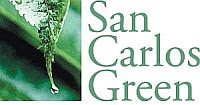Green Building Program Deleted from draft Climate Action Plan
Changes to the draft General Plan Update and a revised version of the Climate Action Plan were posted today with the agenda for the Planning Commission 9/21 hearing. CAP element 3.1b, known as "Option 2" -- the optional language that would have provided for development of a green building program -- has been completely deleted. Text states that "Based on guidance from City Council and the Climate Action Plan Subcommittee, Option 1 will be analyzed in this Plan."
Really? The CAP Subcommittee and General Plan Advisory Committee approved of drafts of the CAP that included both Green Building Option 1 (aka Do Nothing and Hope the State Develops a Robust Green Building Plan) and Option 2 (aka Adopt a Green Building Ordinance Similar to Other Cities). It was intended that City Council decide between the two options, with input from the public.
At the Planning Commission and City Council study sessions, City staff suggested the Commissioners and Council Members "take a look at" the Green Building Options, expressing concern about the cost of such programs. Not one of the City Council members commented on the Green Building options at the study session. So, which council member(s) requested Option 2 be removed, and when? Or was it removed solely by staff, even though it has been strongly supported by the public at every turn?
San Carlos Green intends to request Option 2 be put back in. We encourage you to join us at the Planning Commission hearing Monday, Sept. 21 at 7:00 pm in City Hall.
State "Green Building Code" -- What is it, and why shouldn't we just wait and let the State come up with something?
It would be great to have a robust, state-wide green building code, but we are nowhere close. There has been a lot of talk about the State Green Building Code, but it is not the easiest code to read through and understand the effect of. The 2008 California Green Building Standards Code (24 CCR Part 11) (“CalGreen Code”) currently contains descriptions of many techniques for making construction greener. But very few of these techniques are slated to become mandatory.
CalGreen Code Application Matrix (AM-HCD) (pdf pages 73-74 of the Code linked above) lists the elements applicable to single-family homes and other residential structures under 3 stories.[1] As shown on this Matrix, the requirement that low-flow water fixtures be used or that indoor water use be calculated to be 20% below baseline, and the prohibition against multiple showerheads simultaneously providing one shower with more than the combined maximum federal flow rate, go into effect in July of 2011. A one-and-a-half-page list of other mandatory elements, including low-VOC limits on some products, sealing areas of air leakage between the home and the outside, and covering heat ducts during construction to keep dust out, are slated to go into effect on the effective date of the 2010 round of code updates. The State Building Commission is currently aiming for January of 2011 for the effective date of the 2010 Code updates, so unless the list is modified, this is the list of elements that would become effective in early 2011 for low-rise residential.[2]
The matrix for most other buildings (not including hospitals and public schools) is Application Matrix AM-BSC (pdf pages 66-72 of the code linked above). The list of elements that may become mandatory in the future for this category is the subject of much discussion. The matrix currently only identifies six of the elements as potentially being required, and it is our understanding that most of these are mandated elsewhere in the codes already. As to the rest of the listed elements, according to the Building Standards Commission, the involved government agencies are “looking at their current voluntary regulations to determine which, if any, can be made mandatory, and which others should remain optional.”[3] So it is really a matter of speculation which elements, if any, will become mandatory for commercial and high-rise residential, and when.
The CalGreen Code clearly states that it is not a substitute for the certification requirements of any green building program not adopted by the state BSC, that this code should be viewed as minimal Green Building standards, and that local government entities retain their discretion to exceed these standards.[4] Local governments are provided with a procedure to adopt any of the listed elements as mandatory sooner than the State does[5] – so there is nothing to stop San Carlos from adopting more of these elements as mandatory, and they could do so immediately. However, our understanding from the Building Department staff is that they do not intend to propose for adoption as mandatory any element that is not mandatory state-wide.
[1] E-mail from Jane Taylor, Senior Architect, California Building Standards Commission (CBSC) Dec. 2, 2008.
[2] Telephone conference with Erica of CBSC, Sept. 15, 2009.
[3] E-mail from Jane Taylor.
[4] 24 CCR §§ 101.3, 101.7.
[5] §§ 101.7, 101.7.1; E-mail from Jane Taylor: “local jurisdictions may adopt any or all of the provisions as mandatory, providing they meet the findings requirements.”
Tuesday, September 15, 2009
Subscribe to:
Post Comments (Atom)





No comments:
Post a Comment